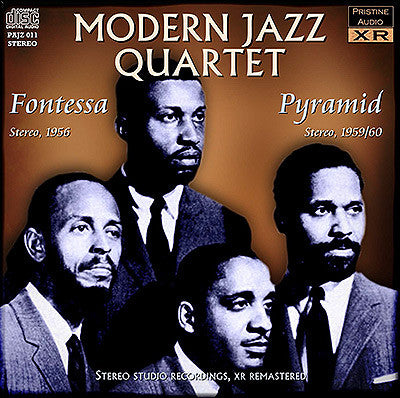
This album is included in the following sets:
This set contains the following albums:
- Producer's Note
- Full Track Listing
- Cover Art
- Additional Notes
The ground-breaking 1956 album Fontessa in full stereo in a new XR remastering
Plus the MJQ's classic 1959/60 recording Pyramid, also given the full Pristine XR treatment
This remastering aims to correct or reduce as much as possible those flaws and present the stereo Fontessa in as good a light as possible. This has required extensive restoration, removing heavy electrical hum, thumps, bumps, hiss and more. In addition, in order to bring some life to the rather dead sound of the stereo mix, I've used a convolution reverberation which recreates perfectly the live acoustic of Birdland in New York, where the MQJ doubtless played on numerous occasions.
The coupling here, Pyramid, demonstrates what further improvements XR remastering can offer an already accomplished studio recording of the era.
Andrew Rose
Fontessa
-
1. Versailles (Porte de Versailles) (3:27)
2. Angel Eyes (3:54)
3. Fontessa (11:17)
4. Over The Rainbow (3:57)
5. Bluesology (4:53)
6. Willow Weep for Me (4:53)
7. Woody 'n You (4:54)
Recorded 22 January & [5] 14 February, 1956, in New Jersey & [5] New York
N.B. Track 5 features a different take to that used on the mono release
Producer: Nesuhi Ertegun
Originally issued as Atlantic SD 1231
-
Pyramid
1. Vendome (2:32)
2. Pyramid (Blues for Junior) (10:53)
3. It Don't Mean A Thing (5:04)
4. Django (4:37)
5. How High The Moon (6:18)
6. Romaine (7:25)
Recorded August 22 & 25 and December 21, 1959 and January 15, 1960
Music Inn, Lenox, Massachusetts and Capitol Studios, New York City
Producer: Nesuhi Ertegun
Originally issued as Atlantic 1325
Fontessa is a 1956 album by the Modern Jazz Quartet released on Atlantic Records. It was the first of their albums released on Atlantic. The album was released in the USA in mono on the black Atlantic label with catalogue number 1231. It was released in the USA in stereo on the green Atlantic label with catalogue number SD 1231. The prefix SD stands for Stereo Disc. The current internationally available CD release is the mono version. A Japanese CD exists of the stereo version. Additionally both mono and stereo versions were released in many other territories, for example the UK with London LTZ-K 15022 for the mono and London SAH-K 6031 for the stereo. The 11-minute title tune was released on a 45 RPM 7-inch EP with the track being split across two sides of the record.
The mono version of the album has a good recorded sound quality as one would expect from an important 1956 jazz release. The stereo version is marred by a number of technical flaws. The first of these is a very powerful mains hum consisting of a 60 Hz tone and it's harmonics at 120 Hz and also 180 hz. The second flaw is a remarkably high level of tape hiss. Lastly the level of the bass playing is much lower than the mono release. The combination of these errors would seem to suggest that the stereo recording was experimental in nature and that these recordings were probably only released after commercial pressure for a stereo version. The quality of the stereo image is high despite these flaws and it is possible to get a true sense of space and position of the players.
Track 5, "Bluesology" features a different take on the mono and stereo versions of the record. A recent multi-CD retrospective release featured the mono version of the album, with the stereo version of this tune as a bonus track.
Gramophone Historic Review
Fontessa - LP review, 1956
OnIy last month John Lewis earned five stars from me for his Modern
Jazz Society issue on Columbia-Clef. Now he wins five more as London
bring out the first recording made by his Modern Jazz Quartet for the
American Atlantic label.
What more can one say about this amazing group than has already been said? Milt Jackson displays his agile inventiveness in Rainbow and Willow; John Lewis takes a firm, imaginative piano solo in Bluesology.
But every track has its special merit, with the two originals by Lewis - Versailles and the suite Fontessa
- especially showing off the Quartet's distinctive qualities. The
former is an intricate, swinging performance. The latter takes up most
of the first side. Fragile, graceful, lyrical, it is beautifully
interpreted by Jackson and Lewis. Connie Kay, who replaced Kenny Clarke,
should also get a diploma for the remarkable use he makes of cymbals
during the final section.
Recording, with Lewis sounding as though he had a real concert grand at his economical but masterly command, is excellent.
E. J., The Gramophone, November 1956

